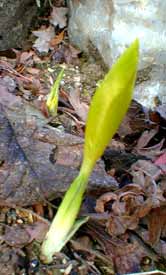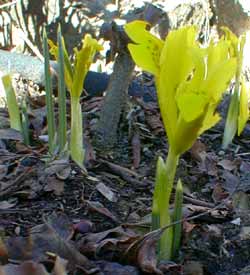
Dwarf Yellow Iris
"Long conversations
beside blooming irises ‚
joys of life on the road."
-Matsuo Basho,
1644-1694
1644-1694
A native wildflower of Turkey, we planted out a dozen thumbnail-sized Iris danfordiae bulbs in autumn (2003), on the morning-sunny side of the dripline of a Milestone Rhododendron. In late winter when these little bulbs erupt, nearby deciduous shrubs & trees are without leaves, so the irises get lots of sun.
 They can tolerate a bit of shade but greatly prefer full morning sun. Sun exposure both morning & afternoon may be too much, though. They're very upright little things so long as they're not terribly exposed, but they tend to blow over if there is nothing at all to provide windbreaks for them, & will be altogether ruined by the first hard rain. For these reasons they are frankly inferior to the dwarf blue I. reticulata.
They can tolerate a bit of shade but greatly prefer full morning sun. Sun exposure both morning & afternoon may be too much, though. They're very upright little things so long as they're not terribly exposed, but they tend to blow over if there is nothing at all to provide windbreaks for them, & will be altogether ruined by the first hard rain. For these reasons they are frankly inferior to the dwarf blue I. reticulata.Additionally, they do not bloom every year & do not have as "complete" a standard iris "flag" flower, they're simply not as interesting as the reticulated iris. They are tempting even so because the reticulated does not include any yellow variety among its numerous cultivars.
Their fragrant, ruffly, & bright canary-yellow flags stand only six inches tall. Usually defined in the literature as blooming "very early spring," this is certainly not accurate for Puget Sound, as they are definitively late-winter bloomers which might still have a few lingering blooms left in earliest spring, but are more likely done by then. In colder zones they will indeed be blooming March & April, but for us they start & end a full month sooner.
Ours are up as bright-bright yellow buds the first week in February, as shown in the first photo. These soon open into bright flags within a day to a week; well before mid-month, as shown in the second photo, they're in full flower.
It blooms slightly ahead of the nearby blue I. reticulata which are showing only a bit of blue in their buds for another couple days to a week after the yellows are fully opened, though ivery soon the dwarf blues & the yellows are blooming simultaneously in the rockery.
These little irises do naturalize with great ease, but I. danfordiae has one peculiarity distinct from that of I. reticulata which more than anything accounts for the comparative lack of popularity for the yellow species. For their first bloom-season in the ground, these little yellow irises flower reliably. But in the couple of years to follow, the bulbs produce so many bulblets that they are practically falling into small segments underground, & the parent bulb has no energy left to bloom again. The young bulbs take three or four years to mature sufficiently to provide flowers anew.
Some people lift the bulbs to remove the bulblets while still tiny, before they can drain the parent bulb. This is supposed to preserve the parent bulb as a yearly bloomer, but is awfully troublesome to do, & not invariably effective, so you wouldn't catch me trying that. So it's easiest to let them do their thing. The cluster of baby bulbs will after three or four years erupt with more flowers than ever. So if you see no blooms their second & third year in the ground, don't worry, they're still fine.
If there are bulbs of various ages present, a drift of dwarf yellow iris will provide flowers every year. You can plan for their behavior by adding a few newly obtained bulbs each autumn for a while, insuring the yearly arrival of miniature yellows. Alternatively -- & this is what I'm planning -- you can mix them with I reticulata for a mixed-color drift, with the blue ones reliable for every year, & vastly less likely to be knocked over by wind or rain, making the occasional presence of the yellows a pleasant change of pace, but not of central importance.
For a great long while they will not need to be lifted for separating out the increasing numbers of bulbs. They do best when not often disturbed, so lifting them should wait until the blooms have obviously declined in number, as will occur when they have finally overcrowded themselves.
They should be in moist well draining ground for winter & spring, but a little summer droughtiness is also required. After the blooms are spent, the remaining spring grass suddenly grows to a foot in height, then dies back for summer dormancy. The grass shouldn't be clipped away until it starts to look yellow & homely.